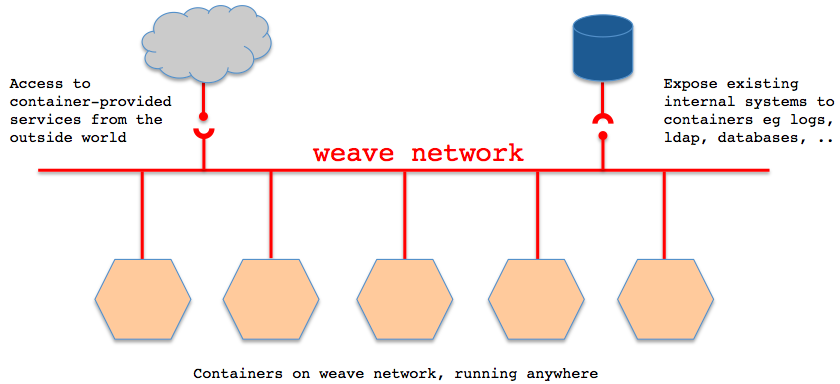使用weave管理docker网络
weave简介
Weave creates a virtual network that connects Docker containers deployed across multiple hosts.

Applications use the network just as if the containers were all plugged into the same network switch, with no need to configure port mappings, links, etc. Services provided by application containers on the weave network can be made accessible to the outside world, regardless of where those containers are running. Similarly, existing internal systems can be exposed to application containers irrespective of their location.

Weave can traverse firewalls and operate in partially connected networks. Traffic can be encrypted, allowing hosts to be connected across an untrusted network.
With weave you can easily construct applications consisting of multiple containers, running anywhere.
Weave works alongside Docker's existing (single host) networking capabilities, so these can continue to be used by containers.
weave简单使用
sudo wget -O /usr/local/bin/weave https://raw.githubusercontent.com/zettio/weave/master/weave
sudo chmod a+x /usr/local/bin/weave启动weave路由器,这个路由器其实也是在docker中启动的:
[root@h-46mow360 ~]# weave launch
Unable to find image 'zettio/weave' locally
3b3a3db2c186fccb5203dcc269b3febbbbf126591a7ebd8117a8a5250683749f
[root@h-46mow360 ~]# brctl show
bridge name bridge id STP enabled interfaces
docker0 8000.56847afe9799 no veth801050a
weave 8000.7afc2a03325e no vethwepl2146
[root@h-46mow360 ~]# docker ps
CONTAINER ID IMAGE COMMAND CREATED STATUS PORTS NAMES
3b3a3db2c186 zettio/weave:git-a34e214201cb "/home/weave/weaver About a minute ago Up About a minute 0.0.0.0:6783->6783/tcp, 0.0.0.0:6783->6783/udp weave在两台物理机上分别启动一个容器:c1=$(weave run 10.0.3.3/24 -t -i -v /sys/fs/cgroup:/sys/fs/cgroup:ro -v /tmp/$(mktemp -d):/run systemd:systemd /usr/lib/systemd/systemd)c2=$(weave run 10.0.3.5/24 -t -i -v /sys/fs/cgroup:/sys/fs/cgroup:ro -v /tmp/$(mktemp -d):/run systemd:systemd /usr/lib/systemd/systemd)这个时候,两个容器之间是不通的,需要在两台weave的路由器之间建立连接:( if there is a firewall between $HOST1 and $HOST2, you must open port 6783 for TCP and UDP)weave connect 10.33.0.9这样,两台容器之间通了:# nsenter --mount --uts --ipc --net --pid --target $(docker inspect --format "{{.State.Pid}}" "$c2")
-bash-4.2# ping -c 3 10.0.3.3
PING 10.0.3.3 (10.0.3.3) 56(84) bytes of data.
64 bytes from 10.0.3.3: icmp_seq=1 ttl=64 time=2.34 ms
64 bytes from 10.0.3.3: icmp_seq=2 ttl=64 time=1.52 ms
64 bytes from 10.0.3.3: icmp_seq=3 ttl=64 time=1.13 ms
--- 10.0.3.3 ping statistics ---
3 packets transmitted, 3 received, 0% packet loss, time 2003ms
rtt min/avg/max/mdev = 1.131/1.667/2.345/0.505 ms- 应用隔离:不同子网容器之间默认隔离的,即便它们位于同一台物理机上也相互不通;不同物理机之间的容器默认也是隔离的
- 物理机之间容器互通:weave connect $OTHER_HOST
- 动态添加网络:对于不是通过weave启动的容器,可以通过weave attach 10.0.1.1/24 $id来添加网络(detach删除网络)
- 安全性:可以通过weave launch -password wEaVe设置一个密码用于weave peers之间加密通信
- 与宿主机网络通信:weave expose 10.0.1.102/24,这个IP会配在weave网桥上
- 查看weave路由状态:weave ps
- 通过NAT实现外网访问docker容器
Weave creates a network bridge on the host. Each container is connected to that bridge via a veth pair, the container side of which is given the IP address & netmask supplied in ‘weave run’. Also connected to the bridge is the weave router container.
A weave router captures Ethernet packets from its bridge-connected interface in promiscuous mode, using ‘pcap’. This typically excludes traffic between local containers, and between the host and local containers, all of which is routed straight over the bridge by the kernel. Captured packets are forwarded over UDP to weave router peers running on other hosts. On receipt of such a packet, a router injects the packet on its bridge interface using ‘pcap’ and/or forwards the packet to peers.
Weave routers learn which peer host a particular MAC address resides on. They combine this knowledge with topology information in order to make routing decisions and thus avoid forwarding every packet to every peer. The topology information captures which peers are connected to which other peers; weave can route packets in partially connected networks with changing topology.
Weave routers establish TCP connections to each other, over which they perform a protocol handshake and subsequently exchange topology information. These connections are encrypted if so configured. Peers also establish UDP “connections”, possibly encrypted, for the aforementioned packet forwarding. These “connections” are duplex and can traverse firewalls.
[Unit]
Documentation=http://zettio.github.io/weave/After=docker.service
[Service]
ExecStartPre=/usr/local/bin/weave launch
ExecStart=/usr/bin/docker logs -f weave
SuccessExitStatus=2
ExecStop=/usr/local/bin/weave stop
[Install]
WantedBy=multi-user.target
使用weave管理docker网络的更多相关文章
- FW:使用weave管理docker网络
Posted on 2014-11-12 22:20 feisky 阅读(1761) 评论(0) 编辑 收藏 weave简介 Weave creates a virtual network that ...
- 【docker专栏8】使用IDEA远程管理docker镜像及容器服务
使用命令行的方式管理服务器镜像及容器是运维人员最常用的方式,但是有的时候我们不得不远程操作docker或者是面向对docker并不熟悉的技术人员提供能力(配置管理员.测试人员),这种情况下图形界面就有 ...
- Docker网络解决方案 - Weave部署记录
前面说到了Flannel的部署,今天这里说下Docker跨主机容器间网络通信的另一个工具Weave的使用.当容器分布在多个不同的主机上时,这些容器之间的相互通信变得复杂起来.容器在不同主机之间都使用的 ...
- Docker网络 Weave
当容器分布在多个不同的主机上时,这些容器之间的相互通信变得复杂起来.容器在不同主机之间都使用的是自己的私有IP地址,不同主机的容器之间进行通讯需要将主机的端口映射到容器的端口上,而且IP地址需要使用主 ...
- [经验分享] Docker网络解决方案-Weave部署记录
前面说到了Flannel的部署,今天这里说下Docker跨主机容器间网络通信的另一个工具Weave的使用.当容器分布在多个不同的主机上时,这些容器之间的相互通信变得复杂起来.容器在不同主机之间都使用的 ...
- docker网络配置方法总结
docker启动时,会在宿主主机上创建一个名为docker0的虚拟网络接口,默认选择172.17.42.1/16,一个16位的子网掩码给容器提供了65534个IP地址.docker0只是一个在绑定到这 ...
- 【转】Docker网络详解及pipework源码解读与实践
好文必转 原文地址: http://www.infoq.com/cn/articles/docker-network-and-pipework-open-source-explanation-prac ...
- Docker网络模式
[编者的话] 本文是<Docker网络及服务发现>一书的一个章节,介绍了搭建Docker单主机网络的基础内容.关于Docker网络的更多内容,包括多主机的网络,请参考该书的其他章节. @C ...
- 一文搞懂各种 Docker 网络 - 每天5分钟玩转 Docker 容器技术(72)
前面各小节我们先后学习了 Docker Overaly,Macvaln,Flannel,Weave 和 Calico 跨主机网络方案.目前这个领域是百家争鸣,而且还有新的方案不断涌现. 本节将从不同维 ...
随机推荐
- eclipse中如何打jar包
在eclipse中写个小测试程序(需要用到第三方jar文件),打成jar文件,然后到linux下执行做测试,查了很多资料也没有说怎么把第三方jar打入jar,使用ant,又太麻烦. 1 选择Mai ...
- Linux下查看tomcat连接数 .
netstat -na | grep ESTAB | grep 80 | wc -l 80是端口号
- Android ——单元测试
什么是单元测试 首先需要介绍一下什么是单元测试.很多人像我一样,本科并不是计算机专业出身的,如果在职的公司不要求做单元测试的话,可能对这个词并没有一个确切的概念.而即使是计算机专业出身,如果毕业以后写 ...
- cell 内部 设置width 总不对
今天 在Cell 里设置屏幕宽 如果 在layoutSubviews 使用 self.width(自己写的分类) 或者 self.view.size.width 都可以,这里 4 4s 5 5s 都 ...
- web api 初体验之 GET和POST传参
上一篇我们讲到了web api跨域的问题 它几乎是每一个用web api的人都需要去解决的问题,不然都没法测试.接下来会遇到的问题就是传参了.还是用js前台调用服务的方式. GET 方式 get方式传 ...
- 关于Windows7的安装纠结过程
关于Windows7的安装过程 背景交代 因为自己有两个笔记本,一个是伴我读过四年大学生活的老华硕笔记本,一个是姐夫不用的上网本.自己的构想是将老笔记本装上Ubuntu Server当作平时开发pyt ...
- android view : window
既然是view,为什么要说window,实际上着是一个很有用的东西,在展现view和设计界面上很有用,就比如说悬浮窗 但是这时候又要分清楚一个概念,window到底是什么?在activity中说过了我 ...
- 深入解析Javascript中this关键字的使用
深入解析Javascript中面向对象编程中的this关键字 在Javascript中this关键字代表函数运行时,自动生成的一个内部对象,只能在函数内部使用.比如: function TestFun ...
- C#数据类型分类
C#是强类型语言,所以在定义每一个变量.常量和对象的时候都必须声明该类型. C#数据类型分为值类型.引用类型和指针类型(指针类型很少用): C#数据类型还可以分为内置类型.匿名类型和自定义类型.
- WEP算法的安全性
翻译自http://www.isaac.cs.berkeley.edu/isaac/wep-faq.html WEP算法的安全性 这篇文章讲述了我们对有线等效加密协议(WEP, 802.11标准的一部 ...
